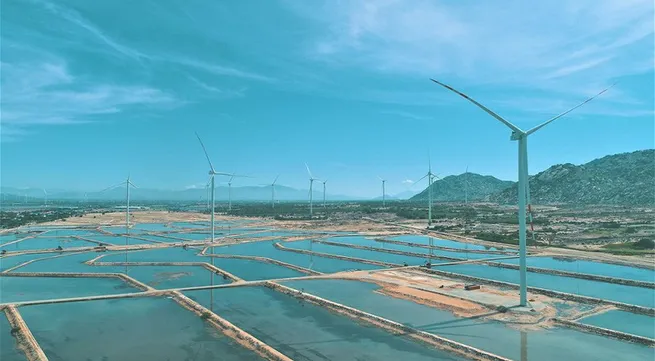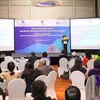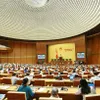National appeal for energy transition assistance receives big response

Vietnam is calling for international assistance to realise its net-zero emission goal by 2050
Early this week, British Ambassador to Vietnam Iain Frew told Deputy Prime Minister Tran Hong Ha that the UK would like further discussion with Vietnam’s relevant agencies regarding possibilities to assist Vietnam in renewable energy, net-zero emissions, and climate change response.
The UK is one of 10 economies in the International Partners Group (IPG) that in mid-December 2022 agreed on a bold just energy transition partnership (JETP).
The JETP will support Vietnam to deliver on its ambitious Net Zero 2050 goal, accelerate the peaking of its greenhouse gas emissions and transition away from fossil fuels to clean energy. It will mobilise initial public and private finance of 15.5 billion USD over the next 3-5 years to support Vietnam’s green transition.
The partnership will assist Vietnam in working towards some new targets, including advancing the projected peaking date for all GHG emissions in Vietnam from 2035 to 2030; reducing peak annual power sector emissions by as much as 30%, from 240 to 170 megatons, and bringing forward the peaking date by five years to 2030; limiting Vietnam’s peak coal capacity to 30.2GW, down from a current planning figure of 37GW; and accelerating the adoption of renewables so that renewable energy accounts for at least 47 percent of electricity generation by 2030, up from the current planned generation share of 36%.
Initial contribution to the Vietnam JETP includes 7.75 billion USD in pledges from the IPG together with the Asian Development Bank and the International Finance Corporation. This is supported by a commitment to work to mobilise and facilitate a matching 7.75 billion USD in private investment from an initial set of private financial institutions coordinated by the Glasgow Financial Alliance for Net Zero, including Bank of America, Citi, Deutsche Bank, HSBC, Macquarie Group, Mizuho Financial Group, MUFG, Prudential PLC, Shinhan Financial Group, SMBC Group, and Standard Chartered.
Underlining the importance of mechanisms to realise ideas and commitments made under the JETP, DPM Ha said, “Vietnam is very much in need of the UK’s support in technology transfer, technical consultation, financial mechanisms, and investor selection for concrete projects in renewable energy (particularly offshore wind energy), forest plantation, carbon capture, green hydrogen production, and research of new technology.”
Within 2023, with the support of partner countries, Vietnam will work to develop and adopt the Vietnam JETP Resource Mobilisation Plan, which will enable the implementation of the JETP funding and strategy.
The United Nations Development Programme (UNDP) also said it is ready to support Vietnam in the detailed formulation and implementation of the JETP resource mobilisation plan in this year.
“This includes our proven technical assistance services to the governments in green transition/nationally appropriate mitigation actions projects, which can help Vietnam identify cost effective de-risking public instruments to promote and scale up private sector investments under the JETP resource mobilisation plan,” said UNDP Resident Representative in Vietnam Ramla Al Khalidi.
The UNDP is now initiating assessments on the impact of phasing-out coal power and energy transition in Vietnam and defining what these processes would specifically mean for the country.
As Vietnam will embark on a greener and more resilient path in the next 3-5 years, including with the JETP, it needs to accelerate preparations for a package of public instruments to de-risk investments in renewable energies and design a just and feasible process to phase out coals in both state-owned enterprises and foreign-invested coal power plants, Khalidi proposed.
In its country partnership strategy (CPS) for Vietnam in the 2023–2026 period, the Asian Development Bank (ADB) also stated that Vietnam is facing twin challenges of meeting rapid energy demand growth with simultaneous decarbonisation. Vietnam’s energy demand has been continuously growing at a higher rate than economic growth.
According to the national utility Electricity of Vietnam, power demand growth was 10.3-11.3% per year in 2016–2020 and is projected to grow by 8–8.5% annually from 2021–2030. To meet its fast-rising energy demand, Vietnam has relied on fossil fuels. CO2 emissions have therefore increased at a rapid rate of 7.9% annually, faster than the real GDP rate (6.5–7% annually).
As a result, Vietnam’s carbon intensity, which measures CO2 emissions per unit of GDP, is higher than that of other countries in ASEAN while fossil CO2 emissions in Vietnam in 2019 were also the highest in ASEAN. Vietnam’s net-zero carbon emissions commitment therefore requires redesigning the strategy for power sector development, including a transition from coal-fired power generation to more environmentally friendly sources of energy.
“The ADB will support Vietnam in transforming the economy (production and consumption) toward more energy-efficient and greener growth,” said the CPS.
Providing support through policy and knowledge, the ADB will assist Vietnam to review its policy framework to operationalise the zero carbon emissions commitment by 2050 and develop a national action plan for implementing a circular economy. Non-sovereign financing will support renewable energy; with non-sovereign and sovereign financing supporting the application of energy saving technologies in power consumption, transmission, and distribution, urban waste treatment, wastewater treatment, and drainage.
The ADB will explore sovereign and non-sovereign financing in the development of low-carbon transport options such as metro lines and electric vehicles. The ADB’s advisory services will help prepare sustainable and bankable green economy projects, including for infrastructure development. Sovereign lending for sustainable tourism development projects will promote green jobs that are environmentally sustainable, resource-saving, and have high value-added.
The ADB technical assistance (TA) and capacity building will support Vietnam’s use of carbon pricing instruments to develop and take advantage of domestic, bilateral, and international carbon markets, and where applicable, integrated markets in achieving the country’s nationally determined contributions and net zero emissions commitments.
According to the World Bank Group (WBG), to ensure sufficient funding for responding to climate change, mobilising domestic finance is possible but external support will be needed.
Overall, Vietnam’s total incremental financing needs for the resilient and decarbonising pathways could reach 368 billion USD between 2022 and 2040, or approximately 6.8% of GDP per year. The resilient pathway alone will account for 4.7% of this amount as substantial financing will be required to protect the country’s assets and infrastructure as well as vulnerable people, the WBG said in a study released last July.
This 368 billion USD in financing needs will include 184 billion USD from private investments (about 3.4% of GDP annually), 130 billion USD from the state budget (about 2.4% of GDP annually), and 54 billion USD from external sources (about 1% of GDP per year).
At COP26 in Glasgow in November 2021, Vietnam impressed the international community by its strong commitment on net-zero target in reducing GHG emissions.
“Although we are a developing country that started industrialisation only over the three decades ago, Vietnam will capitalise on its advantage in renewable energy and take stronger measures to reduce GHG gas emission,” stated Prime Minister Pham Minh Chinh. “To this end, we will make use of our own domestic resources, along with the cooperation and support of the international community, especially from the developed countries, in terms of finance and technology, including through mechanisms under the Paris Agreement, in order to achieve net-zero emissions by 2050.”
Under current projections by the UNDP, 40% of the land area of Vietnam’s Mekong Delta will be inundated by 2100. This will directly impact the local population and have major consequences for national rice production, export rice production, national aquaculture production, and fish exports.





